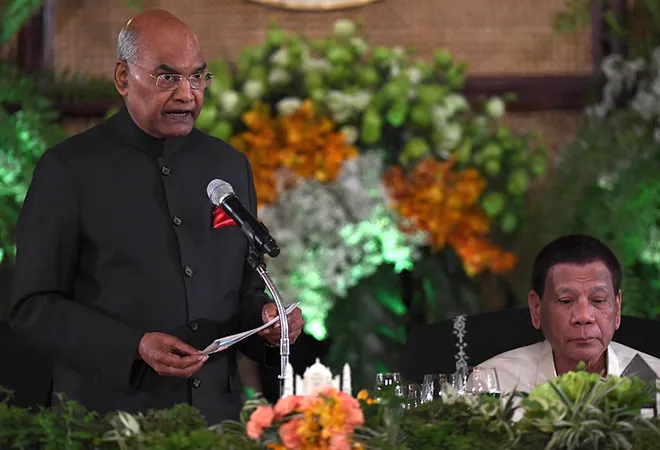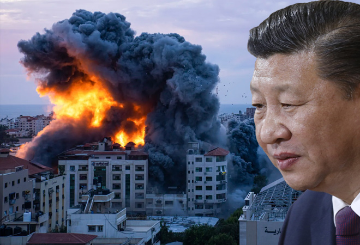
President Kovind recently embarked on a seven-day visit to the Philippines and Japan with an aim to expand bilateral cooperation with these countries as part of India’s Act East policy. President Kovind visited Manila from 17 October to 20 October 2019, where he met with his counterpart Rodrigo Roa Duterte and attended business and community events like India-Philippines Business Conclave and the 4th ASEAN-India Business Summit. The Manila visit took place on the occasion of seventy years of diplomatic relations being established between the two countries. India and Philippines signed four agreements covering maritime domain, security, tourism, science and technology, and culture. Though the Look East policy was initiated by India in the 1990s — primarily with the aim of developing economic and trade relations with its Southeast Asian neighbours — the focus has been mainly on countries like Vietnam, Singapore and with regard to investments in the CML countries (Cambodia, Myanmar and Laos). Countries like Malaysia, Indonesia, Thailand and the Philippines, though, have been important in India’s foreign policy calculus, but the collaboration has been quite basic. It is only after the advent of the Act East policy in 2014 that we see ties with these countries also growing significantly. Philippines is now also seen as a key country in India’s Act East policy and its engagement with the ASEAN.
Given the growing Chinese influence and footprints in India’s backyard in South Asia and the littorals of the Indian Ocean, it seems logical for India to showcase its reach and the depth of its ties in China’s neighbourhood — Southeast Asia — as well. In this regard, strengthening relations with the Philippines is important, given how the current Filipino President Duterte is seen as a pro-China figure even after the continuing skirmishes between the Filipino and the Chinese fishermen in the South China Sea and how China completely shunned away from the 2016 International Tribunal ruling. For long, countries like Vietnam and Philippines have voiced the need for India to do more in the region, especially given the South China Sea debacle. In May 2019, two Indian naval ships, INS Kolkata and Shakti, joined their counterparts from the US, Japan, and the Philippines for a ‘Group Sail’ exercise through the contested waters of the South China Sea, underlining India’s commitment to working with partners to ensure safe and open sea lanes. Though this ‘Group Sail’ is more of a PASSEX which does not have any strategic message undertone, it did send out a positive message to countries like the Philippines as the sail took place in the parts which are claimed by China and its neighbours like the Philippines.
Given the growing Chinese influence and footprints in India’s backyard in South Asia and the littorals of the Indian Ocean, it seems logical for India to showcase its reach and the depth of its ties in China’s neighbourhood — Southeast Asia — as well.
Relationship with the Philippines has diversified further into political-security; trade and industry and people-to-people realms. The year 2017, in particular, was marked by unprecedented high level exchanges culminating in the visit of Prime Minister Narendra Modi to the Philippines to attend the 31st ASEAN and EAS Summits in Manila from 12 to 14 November 2017. This was followed by a back to back visit when President Duterte visited India from 24 to 26 January 2018, to attend the India-ASEAN Commemorative Summit and Republic Day celebrations. Defence relationships between the two countries have been evolving in the areas of capacity building and training, exchange visits of delegations and naval and coast guard ship visits. Indian Navy and coast guard ships regularly visit the Philippines and hold consultations with their counterparts. Recently, ICGS Shaunak visited Manila on 1 February 2019 on the occasion of Indian Coast Guard Day.
India has been championing its Indo-Pacific vision globally after Prime Minister Modi’s keynote address at the Shangri-La dialogue in 2018, where Prime Minister Modi clearly underlined that ASEAN forms the bedrock of India’s Indo-Pacific vision and strategy. Given the geographical location of Southeast Asia, the importance of including ASEAN in the Indo-Pacific dynamic has been recognised by the leading players of the Indo-Pacific region like Japan, United States and Australia as well. In June this year, The ASEAN too released the ASEAN Outlook on the Indo-Pacific, which despite of being a very generic document, lays down the areas of cooperation (maritime cooperation, connectivity, UN Sustainable Development Goals, Economic and other areas of cooperation). Also one must remember that this ‘outlook’ has been deliberated and agreed upon by all the ASEAN member countries even with the debates of the waning of ASEAN Centrality doing the rounds. Therefore, the fact that ASEAN Centrality has been harped on by India as a vital pillar in its Indo-Pacific vision is a step in the right direction. Looking at these potential areas of cooperation (as mentioned above), President Kovind’s visit seems to have been a successful one. The agreement on Sharing of White Shipping Information is indeed a positive development given that the defence and maritime cooperation between the two countries have been a very general and basic one until now. During this visit, India and the Philippines agreed to bolster the defence and maritime security partnership to make it a key pillar of bilateral cooperation, amidst China flexing its military muscles in the region. An agreement to cooperate in enhancing maritime security was signed by the Philippine Coast Guard (PCG) and Indian Navy on 18 October 2019, in Malacañang. The maritime security deal is formally titled “Memorandum of Understanding on the Sharing of White Shipping Information.” It aims to enhance maritime security “through the sharing of information on non-military and non-government shipping vessels between the Philippines and India.” Duterte also mentioned in his statement that the Philippines has grown to realise the importance of India’s role in the Indo-Pacific region.
Given the geographical location of Southeast Asia, the importance of including ASEAN in the Indo-Pacific dynamic has been recognised by the leading players of the Indo-Pacific region like Japan, United States and Australia as well.
The potential for the Philippines-India economic collaboration was also recognised by President Kovind. He pointed out that “both countries share mutual complementarities which can be utilised to deepen trade and investment ties. He said that India’s ‘Make in India’ and next-generation infrastructure programmes and the Philippines’ ‘Build, Build, Build’ infrastructure initiative present immense opportunities for companies and investors on both sides.” Bilateral trade presently stands at USD 2.32 billion (Exports from India USD 1.74 billion, India’s imports USD 581 million). The existing full potential has not been realised yet even though there has been a positive growth in trade between the two countries after the signing of the Agreement on Trade in Goods on 13 August 2009 between India and ASEAN which was fully implemented in 2011. There is a need to further facilitate trade between the two countries as even though ASEAN-India trade has jumped significantly in the past few years, there is still a long distance to be covered in order to reach the target of USD 200 billion by 2022.
Coupled with the current development trajectory in the Philippines and with India’s Act East policy and its Indo-Pacific vision gaining momentum, the stage appears to be set for further intensification in bilateral relations, covering a broad canvas of consultations and cooperation on matters related to foreign policy, security, defence, maritime, trade, tourism, health, agriculture, people-to-people relations and culture.
The views expressed above belong to the author(s). ORF research and analyses now available on Telegram! Click here to access our curated content — blogs, longforms and interviews.




 PREV
PREV


